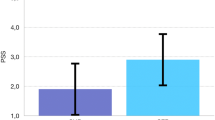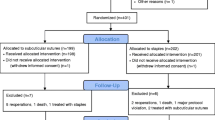Abstract
Background
The creation of a stoma is commonplace in colorectal surgery. Circumferential subcuticular wound approximation (CSWA) is a method of wound closure following stoma reversal that has been reported to result in decreased wound infection rates and more desirable aesthetic outcomes. The aim of the present study was to determine the effectiveness of the CSWA method, in terms of wound infection and cosmesis by comparing the technique to the conventional method of wound closure.
Methods
All adult patients who presented for stoma reversal at the outpatient clinic of the Division of Colorectal Surgery at the Philippine General Hospital were randomized into two groups, CSWA and conventional. Patients were followed up for up to 30 days postoperatively, photographic documentation of wound appearance was obtained, and wound infections and complications were documented. Patients were asked to complete a satisfaction survey at the end of the follow-up period.
Results
A total of 121 patients were included in the study. One (1.6 %) patient in the CSWA group developed wound infection, while six (10 %) patients in the conventional group had a wound infection (p = 0.061). The CSWA group had a higher total satisfaction score than the conventional group (25 and 24, respectively, p = 0.012).
Conclusions
With regard to wound infection rates, the CSWA method was better than the conventional method, although this was found to be borderline significant. With regard to patient satisfaction, the CSWA method proved to be superior to the conventional method, and this was found to be statistically significant. In addition, the technique is applicable to all forms of stoma regardless of the bowel segment involved, trephine size, and indication for diversion.





Similar content being viewed by others
References
Lahat G, Tulchinsky H, Goldman G, Klauzner JM, Rabau M (2005) Wound infection after ileostomy closure: a prospective randomized study comparing primary vs delayed primary closure techniques. Tech Coloproctol 9:206–208
Milanchi S, Nasseri Y, Kidner T, Fleshner P (2009) Wound infection after ileostomy closure can be eliminated by circumferential subcuticular wound approximation. Dis Colon Rectum 52:469–474
Banerjee A (1997) Pursestring skin closure after stoma reversal. Dis Colon Rectum 40:993–994
Integrated Surgical Information System (ISIS). Department of Surgery Electronic Patient Registry. http://isis.upm.edu.ph
Mileski WJ, Rege RV, Joehl RJ, Nahrwold DL (1990) Rates of morbidity and mortality after closure of loop and end colostomy. Surg Gynecol Obstet 171:17–21
Pittman DM, Smith LE (1985) Complications of colostomy closure. Dis Colon Rectum 28:836–843
Hackam DJ, Rotstein OD (1995) Stoma closure and wound infection: an evaluation of risk factors. Can J Surg 38:144–148
Wong K, Remzi FH, Gorgun E et al (2005) Loop ileostomy closure after restorative proctocolectomy: outcome in 1,504 patients. Dis Colon Rectum 48:243–250
Haase O, Raue W, Bohm B, Neuss H, Scharfenberg M, Schwenk W (2005) Subcutaneous gentamycin implant to reduce wound infections after loop-ileostomy closure: a randomized, double-blind, placebo-controlled trial. Dis Colon Rectum 48:2025–2031
Reid K, Pockney P, Pollitt T, Draganic B, Smith SR (2010) Randomized clinical trial of short-term outcomes following purse-string versus conventional closure of ileostomy wounds. Br J Surg 97:1511–1517
Vermulst N, Vermeulen J, Hazebroek EJ, Coene PP, van der Harst E (2006) Primary closure of the skin after stoma closure. Management of wound infections is easy without (long-term) complications. Dig Surg 23:255–258
Conflict of interest
The authors declare that they have no conflict of interest.
Human and animal rights
The study was approved by the Philippine General Hospital Expanded Hospital Research Office (EHRO). It underwent evaluation and approval from the Department of Surgery’s Technical Review Board and Philippine General Hospital’s Ethics Review Board.
Informed consent
Informed consent was obtained from all individual participants included in the study.
Author information
Authors and Affiliations
Corresponding author
Rights and permissions
About this article
Cite this article
Lopez, M.P.J., Melendres, M.F.A., Maglangit, S.A.C.A. et al. A randomized controlled clinical trial comparing the outcomes of circumferential subcuticular wound approximation (CSWA) with conventional wound closure after stoma reversal. Tech Coloproctol 19, 461–468 (2015). https://doi.org/10.1007/s10151-015-1322-5
Received:
Accepted:
Published:
Issue Date:
DOI: https://doi.org/10.1007/s10151-015-1322-5




